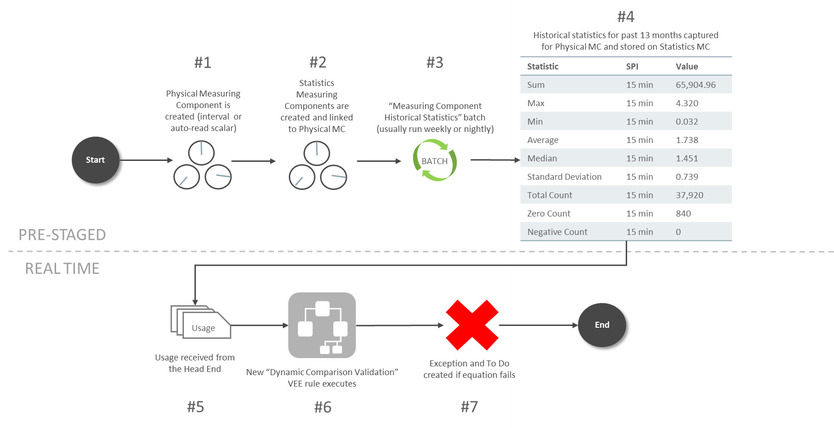Understanding Measuring Component Statistics
Oracle Utilities Meter Data Management provides a way to stage statistics for Measuring Components in order to speed up VEE processing. These statistics are primarily meant for use in conjunction with the Dynamic Comparison Validation VEE Rule, but could also be generated for other analytics or reporting.
Some of the potential benefits of using Measuring Component Statistics are:
- Reduce the data volume for VEE queries by up to 1000 times (this is most beneficial when replacing VEE Rules that query historical data such as High/Low)
- Offload heavier processing of historical data to "system downtimes" - potentially nights or weekends
Below is an overview example of how Measuring Component Statistics can be implemented along with the Dynamic Comparison Validation:

The steps for pre-staging Measuring Component Statistics are detailed below:
- A Physical Measuring Component is created. The algorithm to trigger the creation of Statistics Measuring Components is only set on Interval or Auto-Read Scalar BOs as part of base product.
- New Statistics Measuring Component are created and linked to the Physical Measuring Component.
- The Measuring Component Historical Statistics Batch (D1-MCHS) is run based on the schedule you've defined. The suggestion is to run this either nightly or on the weekends during quieter times for overall system processing.
- A measurement is created for the Statistics Measuring Component that holds historical statistics related to the Physical Meter for a specific period of time (in this example it's set for 13 months).
The steps for how VEE can take advantage of Measuring Component Statistics are detailed below:
- IMDs are received from the Head End.
- The Dynamic Comparison Validation VEE Rule is configured to execute for the meter. This validation uses the historical statistics from the Statistics Measuring Component in order to perform its validation logic.
- An exception and potentially a To Do is generated based on the failure of the VEE rule.
Storage Impact from Statistics
Much consideration was given to the storage implications when designing Measuring Component Statistics. Below is an outline of the storage impact to customers who choose to calculate and store Channel Statistics. An example impact to a utility with 1 million Physical Meters (each with 4 channels of information) is shown in the far right column:
|
Area |
Additional Data in MDM |
Example Impact (assuming utility has 1 million Physical Meters) |
|
Additional MCs Assumption: Statistics are only configured on the primary billing channel MC Type for the majority of your Physical Meters. |
1-3 extra MCs per Physical Meter Assumption: customers will only configure Statistics on their primary billing channel MC Type for the majority of their Physical Meters. |
1 - 3 million extra MCs This increases the Measuring Component table by an extra 25% to 75% from its size without statistics. |
|
Additional Measurements If 'Statistics Retention Mode' configured as "Only Retain Most Recent Record". |
1 extra Measurement per Physical Meter |
1 - 3 million extra Measurements for the life of MDM This data is a minuscule fraction compared to the overall AMI data footprint. |
|
Additional Measurements If 'Statistics Retention Mode' configured as "Retain Historical Records". |
1 extra Measurement per Physical Meter per week |
1 - 3 million extra Measurements per week (52-156 million per year) This data is 0.2-0.5% of the size of the AMI data collected in that same week. |
